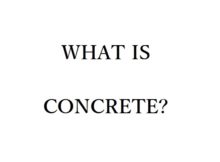Rebound Hammer Test
The rebound hammer test is a non – non-destructive test used to evaluate the compressive strength or the hardness of any concrete element without destruction of that particular element or the structure. The rebound hammer provides a quick indication regarding the compressive strength of concrete.
This test is a simple and rapid test, providing the results immediately without any problematic and complex calculations. The rebound hammer test is a widely used method for non-destructive testing of any concrete element.

The apparatus used for rebound hammer test, popularly known as the Schmidt rebound hammer or a Swiss hammer, was developed by Swiss engineer Ernst Schmidt in the year 1984.

Objective
The objectives of rebound hammer test are as follows:-
1. To find out the compressive strength of concrete with suitable correlations between the compressive strength and rebound index.
2. To evaluate the uniformity of concrete.
3. To evaluate the quality of concrete on the basis of standard requirements.
4. To compare the quality of one element of concrete with the other element.
Principle Of Test
This test is based on the principle that the rebound of an elastic mass depends on the hardness of the concrete surface against which the mass collides.
The rebound hammer comprises a plunger which is attached to a spring-driven metal mass. The plunger is held to a smooth concrete surface. It is held at an angle of 90 degrees and firmly pressed at the concrete surface.
The metal mass controlled by a spring in the hammer rebounds when strikes concrete surface. The amount of rebound of the metal mass is noted on a graduated scale which gives an indication of the compressive strength of concrete.
The strength of concrete is directly proportional to the hardness of the surface of the concrete. So the quality of concrete, in terms of its compressive strength, is said to be better if the rebound is higher and vice versa.
Procedure
Before the commencement of the rebound hammer test, the rebound hammer which is to be used is calibrated against a steel test anvil having a Brinell hardness number of 5000 MPa. Once the rebound hammer is calibrated and ready for use, the test is conducted.
To start with, the Swiss hammer is held at a right angle against the concrete structure. The Swiss hammer is then stroked against the structure.
The hammer stroked at the structure bounces back with some amount of force which the reading is shown on the graduated scale given on the rebound hammer itself and recorded.
On average 10 to 12 readings are taken to get better accuracy of results. Because sometimes the rebound number could be abnormally high due to the presence of large aggregates immediately underneath the plunge or it may be too low due to some voids present beneath the plunge of the hammer. So, it is advised to take at least 8 readings for more accurate results.

This test can be conducted on an element placed vertically or horizontally, keeping in mind that the rebound hammers should be placed at 90 degrees to it.
The rebound value obtained from the test defines the quality of the concrete element or its compressive strength of it. Different rebound values indicate the different quality of structure, as mentioned in the table below.
| REBOUND NUMBER VALUE | QUALITY OF CONCRETE ELEMENT |
| Greater than 40 | Very good hard layer |
| 30 to 40 | Good layer |
| 20 to 30 | Fair layer |
| Less than 20 | Poor layer |
| 0 | Very poor layer |
Points To Remember Before Test
1. The surface of concrete on which the test is to be performed should be clean, smooth, and dry.
2. Loose particles or any unwanted particles on the surface of the concrete should be chipped off using a grinder or other equipment.
3. This test should not be conducted on a rough surface as that would not give the required results.
4. The rebound hammer should be calibrated and tested before the commencement of the actual test.
Advantages Of Rebound Hammer Test
1. Rebound hammer is easy to use. No special skills are required to use a rebound hammer.
2. Rebound hammer is inexpensive equipment.
3. This test is used for repairs and rehabilitation of old structures.
4. It gives instant results.
5. The process of rebound hammer test is also easier and speedy.
Disadvantages Of Rebound Hammer Test
1. The results acquired from the rebound hammer test are accurate up to a certain limit. So they are sometimes not considered as a final call for any kind of decision regarding the structure.
2. The rebound hammer requires maintenance on a regular basis.
3. If the rebound hammer is not pushed at a right angle, a variety of results can be acquired for a single point. So it is not considered a highly accurate method.
Factors Affecting The Result Of Rebound Hammer Test
There are some factors that affect the test result. They are as follows:-
- Types of cement and the content of cement.
- Types of coarse aggregates in concrete.
- The smoothness of the concrete surface.
- The age of concrete.
- The water content of the concrete.
- Size and shape of the concrete element.
Also Read
California Bearing Ratio Test – CBR Test
Types Of Soil Tests For Building Construction
If you like this article, then please share it with your friends & also like our Facebook Page and join our Telegram Channel.





That’s very good and educative. I used this hammer during my service year in one of our site visitation.
VERY CORRECT AND USEFUL.